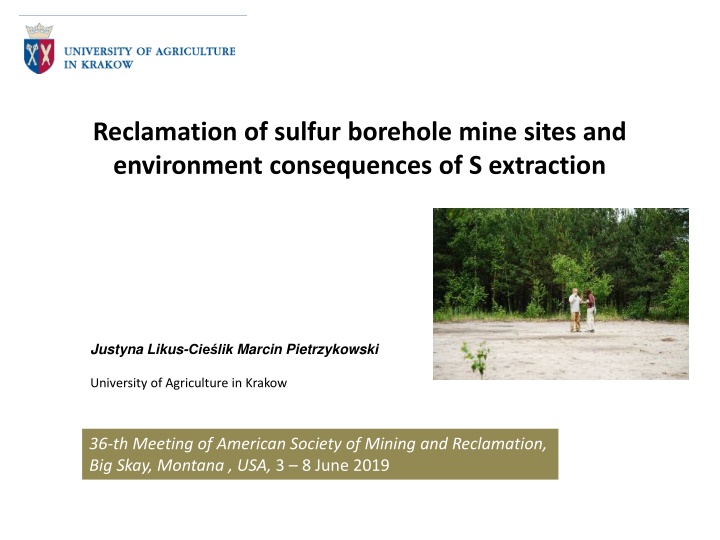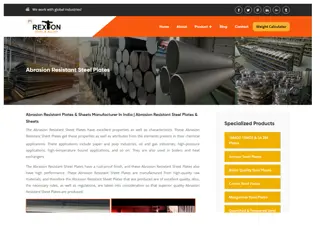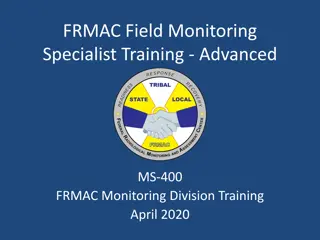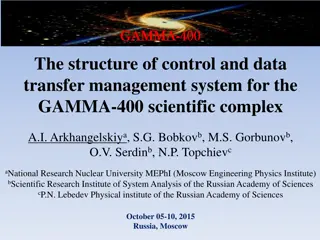
Reclamation of Sulfur Borehole Mine Sites and Environmental Consequences
Explore the reclamation of sulfur borehole mine sites and the environmental impacts of sulfur extraction methods. Learn about the challenges faced in reclaiming former sulfur mines and the goals of related research studies, including soil contamination assessment and vegetation growth reactions. Discover the reclamation treatment process initiated in 1993, involving infrastructure removal, landscape improvements, pH neutralization, fertilization, grass seeding, and afforestation efforts with various tree species.
Download Presentation

Please find below an Image/Link to download the presentation.
The content on the website is provided AS IS for your information and personal use only. It may not be sold, licensed, or shared on other websites without obtaining consent from the author. If you encounter any issues during the download, it is possible that the publisher has removed the file from their server.
You are allowed to download the files provided on this website for personal or commercial use, subject to the condition that they are used lawfully. All files are the property of their respective owners.
The content on the website is provided AS IS for your information and personal use only. It may not be sold, licensed, or shared on other websites without obtaining consent from the author.
E N D
Presentation Transcript
Reclamation of sulfur borehole mine sites and environment consequences of S extraction Justyna Likus-Cie lik Marcin Pietrzykowski University of Agriculture in Krakow 36-th Meeting of American Society of Mining and Reclamation, Big Skay, Montana , USA, 3 8 June 2019
Introduction sulfur mining Sulfur eksploatation methods: Opencast Piaseczno, Mach w sulfur mine) Borehole method (Frasch method; Jezi rko, Grzyb w, Mach w II Basznia s.m., as well as USA and Iraq (TSI 2017). method (Poland: Fig. 1. Schem of boreholue sulfur mining; resource: http://www.nuroil.com Photo by Krzaklewski W. 2 https://upload.wikimedia.org/wikipedia/commons/4/44/Sulfur-sample.jpg
Introduction - reclamation in the case of the borehole mining method, chemical, geomechanical and hydrological transformations of the environment are occured reclamation of former sulfur mine Jezi rko chemical transformations were the biggest challenge for reclamation Photo by J.Likus-Cie lik 3
Why the studies were conducted? Goals: 1. 2. 3. 4. degree of topsoil contamination by sulfur chemistry and seasonal variability of surface water AMD risk assessment Vegetation and trees growth reaction, viability and macronutrient supply chemistry and dynamics of soil solution (sulfur load leachated from sulfated soil substrates and potential remediation effect of birch and pine liter) 5. 4
Research area 7 sq km (3.7 sq km PGL LP) Reclamation to forest 3.32 sq km 0.42 sq km Nowa D ba forest inspectorate Rozwad w forest inspectorate 2.17 sq km researched area Fig. 2 Location of research area, ad border of reclaimed and aforested area tansferred to Forest State administration (Likus-Cie lik et al. 2015)
Reclamation treatment Reclamation treatment started in 1993 and included: Removing main infrastructure (wells, pipelines, access roads); Improving hydrographic condition, landscaping, neutralizing the pH by liming: 400-500 Mg ha-1 of sludge lime; Fertylizing 70 kg ha-1 P2O5, 60 kg ha-1 K2O; Sewing grasses; Afforestation by Scots pine, silver birch and boreal oak Photo by J.Likus-Cie lik 6 Photo by Geoportal.gov.pl
Methods Assessment of the degree and spatial distribution of sulfur soil contamination 88research points: Soil samples from toplayer 0-20 cm: Soil composiion, pH, EC, Coi organic carbon (SOC), Total ntrogen (NT), Toal slfur (ST), The degree of sulfur soil contamination basis on polish standards by Institute of Soil Cultivation and Fertilization assessment of land cover by vegetation (bais on Braun-Blanquet scale) on the circular plots (r=5,64 m, 100 m2 ) Fig. 3. Schem of research points location on reclaimed and afforested FSMJ area 7
Methods Chemistry of surface water 15 monitoring points on streams and pounds in four seasons: summer, autumn, winter and spring analyses: pH, EC, Ion composition (Ca2+ Mg2+, Na+, NO3 , SO42 , Cl , HCO3 ) 8 Fig. 4. Research point localization
Methods Soil parameters and vegetation assessment 3 category of land cover class: the category of areas effectively reclaimed and afforested in pine stands P the category of areas effectively reclaimed and afforested in birch stands B Degraded category D cat. D cat. P cat. B 9
Methods Soil parametries and vegetation assessment 12 (1-ares) Research plots in 4 replication for category Soil sampling: 0-5 and 5-40 cm; vegetaion cover degree by Braun-Blanquet scale; trees measurement (D1,3, Ht); pine, birch foliage, wood-small- reed leafs collecting laboratory analysis: soil samples: pH, EC, ST, SOC,NT plant foliage samples: N, S, Na, K, Ca, Mg, P. Fig.5. Localizaion of research plots in tree categories 10
Methods Chemistry of soil solution and the influence of organic matter in the form of a tree litter on the rate of sulfur oxidation from the soil substrate tested in the experiment under controlled conditions 6 variants of composits in 4 replication (composite = substrate+tree litter) 2 variants of soil contamination by sulfur: LS (low sulfurised) mean 5090 mg kg- 1 S; HS (high sulfurised) mean 42500 mg kg-1 S; 2 types of litter (birch B, pine P) (birch and pine) properties; Once at week soil solution was measured; Start and final basics soil and liter Fig. 6. Schem of experiment under controlled condition Basal respiration rate was measured 11
Results Assessment of the degree and spatial distribution of sulfur soil contamination pHKCl 2,6 - 7,6; EC 15- 2080 S cm 1; ST 10 - 45740 mg kg 1 Herbaceous vegetation cover 10-70% Strong positive corelattion ST and EC (r=0,80) as well as ST and pH (r=0,42) Tree cover Herbaceous vegetation Fig. 7. Arrangement of sampling points grid (a) and spatial distribution of pH (b), EC (c), S concentration (ST) (d), tree cover (e) and herbaceous vegetation (f). 12 Likus-Cie lik et al. 2017. Environ Monit Assess, 189:87.
Results Chemistry of surface water no differences of surface waters between seasons were found; pH 2.6 7.9; Occured point with extremelly low pH 2.6 3.1; mean EC 1797 S cm-1 (1083 - 3430 S cm-1); SO42- concentration 472 - 1503 mg L-1. Season summer autumn winter spring pH 6,5 (3,1-7,7) 6,6 (3,4-7,7) 6,2 (2,7-7,2) 6,7 (2,6-7,9) S cm-1 EC 1819 (1660-2070) 1823 (1720 -2120) 1823 (1083-2190) 1980 (1118-3430) SO42 mg L-1 1049,39 (829,5-1321,9) 994,52 (593,8-1312,2) 742,48 (472,0-988,1) 954,11 (500,2-1502,9) Ca2+ 358,32 (276,3-405,8) 343,00 (197,9-406,7) 285,40 (174,5-390,6) 342,75 (222,3-433,9) mg L-1 1 6,5 (3,1-7,7) mean and range 13 Likus-Cie lik et al. 2017. [w:] M. Czop, M. Kajda-Szcze niak (red.), Wsp czesne Problemy Ochrony rodowiska IV, str. 41-46.
Results Soil parametries and vegetation assessment (detailed area) cat. D cat. P cat. B category Soil layer [cm] 0-5 pHKCl EC [ S cm-1] 154- 908 (370) ST [%] 1,9-6,5 (4,5) 0,06-2,89 (1,18) D 5-40 2,0-6,1 (4,4) 149-1160 (439) 0,20-1,26 (0,78) 0-5 6,0-7,1 (6,6) 102-780 (328) 0,001-0,04 (0,03) P 5-40 3,9-6,7 (6,3) 46-1030 (515) 0,003-0,12 (0,06) 0-5 6,2-6,6 (6,5) 147-1900 (1184) 0,009-0.53 (0,18) B 5-40 4,5-6,3 (6,9) 38-1300 (681) 0,01-1.04 (0,50) 14 Likus-Cie lik et al. 2015. Geology, Geophysics & Environment, 41(4): 371-380.
Results Soil parametries and vegetation assessment (detailed area) cat. D cat. P cat. B IUFRO classification Herbaceous vegetation cover N D1,3 Ht V 10 20 30 [pcs.ha- 1] category [m3.ar-1] [cm] [m] [%] [%] [%] [%] 612 7,7 5,5 0,06 7 40 53 26 D 1457 10,6 10,0 0,93 25 63 12 35 P 1558 7,8 8,3 0,50 9 70 21 74 B 15 Likus-Cie lik et al. 2015. Geology, Geophysics & Environment, 41(4): 371-380.
Results Chemistry of the photosynthetic apparatus of trees and herbaceous vegetation, and the mineral condition of trees trees: In deficite N (Pc current year, and Pc+1 one year needles) B Pc 1272b 188 Pc+1 1221b 235 1954a 689 [mg kg-1] S 1.71a 0.14 1.12 b 0.12 1.11b 0.06 N [%] 2320.4a 533.7 1348.1b 104.3 1045.4b 63.1 [mg kg-1] P 16 Likus-Cie lik et al. 2017. Environ Sci Pollut R, 24(25), 20556-20566.
Results Chemistry of the photosynthetic apparatus of trees and herbaceous vegetation, and the mineral condition of trees Wood-small-reed: In deficite N and P The elevated concentration of S was no found P 2249.1a 127.5 0.93a 0.16 1351.2a 78.3 B 1717.3a 348.7 0.75ab 0.2 1132.5a 280.1 D 1778.5a 682.4 0.62b 0.15 904a 488.5 [mg kg-1] [%] [mg kg-1] S N P 17 Likus-Cie lik et al. 2017. Environ Sci Pollut R, 24(25), 20556-20566.
Results Chemistry of soil solution and the influence of organic matter in the form of a tree litter on the rate of sulfur oxidation from the soil substrate tested in the experiment under controlled conditions 50000 b the type of used substrate (LS low sulfurised, HS high sulfurised) had an influence on the rate and amount of leached elements; Tree litter affects the increase of pH and and increased leaching of DOC, NT i Mg; pH was the main cause of low microbial activity; LS LS significantly lower the EC value; c 45000 c 40000 c 35000 St [mg kg -1] 30000 25000 20000 15000 10000 a a a a 5000 0 LS LS-c LS-B LS-P HS HS-c HS-B HS-P s f s f 14.00 4.5 12.00 4.0 LS-B 10.00 3.5 LS-P PEW [mS cm-1] 8.00 pH 3.0 6.00 LS-c 2.5 4.00 HS-B 2.0 2.00 HS-P 0.00 1.5 HS-c 1 2 3 4 5 6 7 8 9 10 11 12 1 2 3 4 5 6 7 8 9 10 11 12 week week 18 Likus-Cie lik et al. 2018. ZN UZ I , 167 (47): 34-46; Likus-Cie lik et al. 2018. Water Air Soil Poll, 229:71.
Sumary and conclusion in the researched area there are still hot spots of very high concentration of sulfur in the soil (even up to 45000 mg kg-1), low pH <2.0, and EC reaches even 2080 S cm-1; surface waters were characterized by good chemical parameters, however there were points (hot spots) with low pH and high SO42-; after neutralization, the growth of herbaceous plants and trees was possible, birch and pine stands was characterized by relatively good growth parameters and viability; Wood small-reed had high tole to high sulfur concentration in soil the function of temporary biological stabilization; Organic matter had influence tosoil solution dynamisc, but had not influence to increasing the leaching of mineral sulfur, which is the result of only washing the substrates; significant reduction of sulfur content in the substrate as a result of washing will take place in the contaminated environment for a long time and without neutralization the soil detoxification effect will not be achieved. 19
Sumary and conclusion in the researched area there are still hot spots of very high concentration of sulfur in the soil (even up to 45000 mg kg-1), low pH <2.0, and EC reaches even 2080 S cm-1; surface waters were characterized by good chemical parameters, however there were points (hot spots) with low pH and high SO42-; after neutralization, the growth of herbaceous plants and trees was possible, birch and pine stands was characterized by relatively good growth parameters and viability; Wood small-reed had high tole to high sulfur concentration in soil the function of temporary biological stabilization; Organic matter had influence tosoil solution dynamisc, but had not influence to increasing the leaching of mineral sulfur, which is the result of only washing the substrates; significant reduction of sulfur content in the substrate as a result of washing will take place in the contaminated environment for a long time and without neutralization the soil detoxification effect will not be achieved. 20
Sumary and conclusion in the researched area there are still hot spots of very high concentration of sulfur in the soil (even up to 45000 mg kg-1), low pH <2.0, and EC reaches even 2080 S cm-1; surface waters were characterized by good chemical parameters, however there were points (hot spots) with low pH and high SO42-; after neutralization, the growth of herbaceous plants and trees was possible, birch and pine stands was characterized by relatively good growth parameters and viability; Wood small-reed had high tole to high sulfur concentration in soil the function of temporary biological stabilization; Organic matter had influence tosoil solution dynamisc, but had not influence to increasing the leaching of mineral sulfur, which is the result of only washing the substrates; significant reduction of sulfur content in the substrate as a result of washing will take place in the contaminated environment for a long time and without neutralization the soil detoxification effect will not be achieved. 21
Sumary and conclusion in the researched area there are still hot spots of very high concentration of sulfur in the soil (even up to 45000 mg kg-1), low pH <2.0, and EC reaches even 2080 S cm-1; surface waters were characterized by good chemical parameters, however there were points (hot spots) with low pH and high SO42-; after neutralization, the growth of herbaceous plants and trees was possible, birch and pine stands was characterized by relatively good growth parameters and viability; Wood small-reed had high tole to high sulfur concentration in soil the function of temporary biological stabilization; Organic matter had influence tosoil solution dynamisc, but had not influence to increasing the leaching of mineral sulfur, which is the result of only washing the substrates; significant reduction of sulfur content in the substrate as a result of washing will take place in the contaminated environment for a long time and without neutralization the soil detoxification effect will not be achieved. 22
Sumary and conclusion in the researched area there are still hot spots of very high concentration of sulfur in the soil (even up to 45000 mg kg-1), low pH <2.0, and EC reaches even 2080 S cm-1; surface waters were characterized by good chemical parameters, however there were points (hot spots) with low pH and high SO42-; after neutralization, the growth of herbaceous plants and trees was possible, birch and pine stands was characterized by relatively good growth parameters and viability; Wood small-reed had high tole to high sulfur concentration in soil the function of temporary biological stabilization; Organic matter had influence tosoil solution dynamisc, but had not influence to increasing the leaching of mineral sulfur, which is the result of only washing the substrates; significant reduction of sulfur content in the substrate as a result of washing will take place in the contaminated environment for a long time and without neutralization the soil detoxification effect will not be achieved. 23














